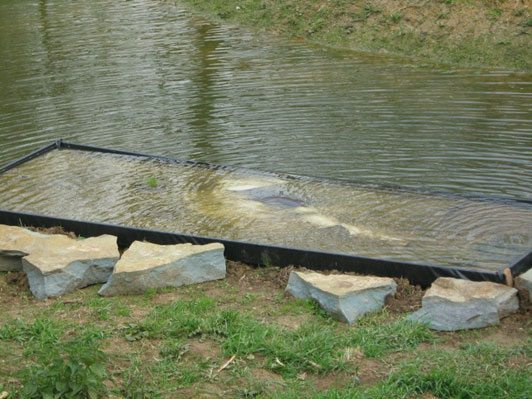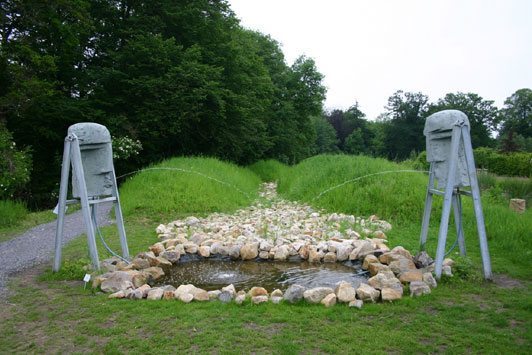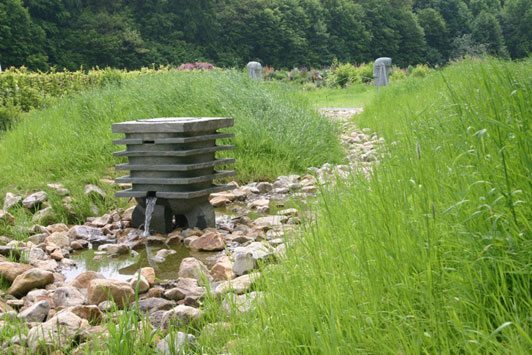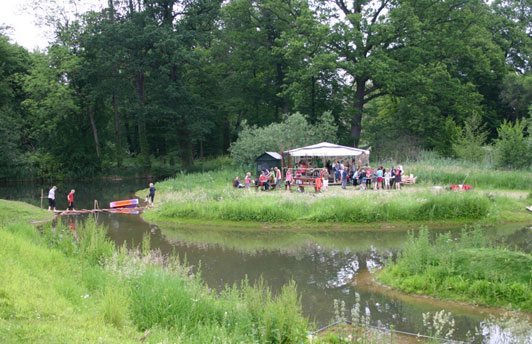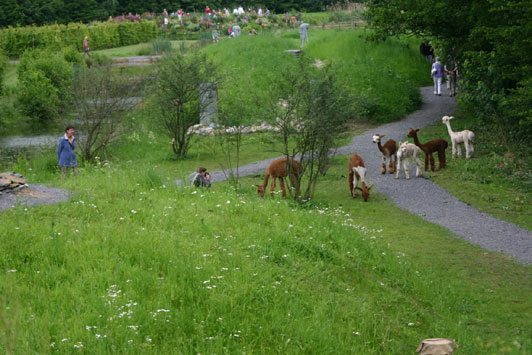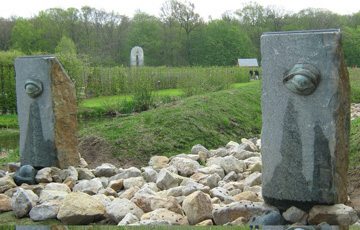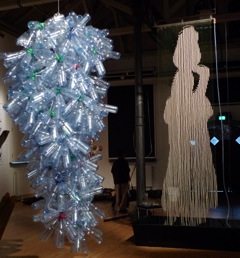Location: Hude, Germany
I. PROLOG
I HAVE BEEN CREATING ENVIRONMENTAL ART PROJECTS for more than twenty-five years. I invite fellow artists to work together and with me. These projects enhance the quality of art by engaging issues, contexts, and history. They also demand research often several years ahead of time. We create social land art, with the local municipality, an specific area, or a special type of landscape. Together we enter into a dialogue about art. Life and nature becomes equated with art and nature.
I am even happier now as more curators are taking on board this kind of philosophy of art and environment, of art and sustainability. These curators require an absolute real-life context for artworks. The result is a fluid boundary between the makers and promoters of such interventions. We need to find more places and spaces for the appreciation of this work in the context of sustainable development. At the same time, we need to promote this establishment in the ‘art world’ itself. So far, this is not often the fact for established art dealers.
II. WATERLANDSCAPE, Germany
IN SEPTEMBER, A NEW KIND OF RAINFALL OCCURRED IN the area of Osnabruck, near my home in northern Germany. Over 1,000 basements were under water. This recently happened in many parts of the world and had been predicted several years ago by researchers in climate change.
A cloud suddenly opens, there is a deluge of heavy rain, and the amenities for normal runoff into rivers, sewerage, etc are not sufficient. But residents here in Germany could bear it with composure when compared to the extensive flooding in Pakistan. Despite the increasing diagnoses, prophecies and increasing natural disasters for people around the world, climate change is still played down in the consciousness of the population. Instead people say such things as, ‘Thirty years ago there was also such weather.’
In the discussion on sustainable development in Germany at the beginning of the third millennium, a new discovery was made, the cultural dimension of sustainability. In discussions by Hildegard Kurt,[1] and since then the Council for Sustainable Development debate on climate change, culture and art is now promoted as a catalyst for a mission of sustainability. This has been shown in many conferences on the dialogue of art, culture, and climate change.[2]
Environmental institutions, like NABU and the German Federal Environmental Foundation, have since learned that the decline of willingness towards nature conservation comes not only through the media and horror scenarios, but is linked to the lack of education on nature.
This is the basis for the project Water Landscape sponsored by the German Federal Environmental Foundation, as part of the County Flower Show, in Lower Saxony, Bad Essen this year. It was created as a terrain that would initiate an improvement in the education of young people on the cultural nature of water.
The need for a water environment was envisaged under the auspices of the Baroness von dem Bussche and the educational vision of Gerhard Lohmeier. It could be ideally combined with my ideas for an overall ecological concept and could be implemented as a landscape planning project on the site of Ippenburg Castle.
The terrain of the landscape is in itself an expansion of the existing moat. The excavation of the new water surfaces, designed as a reference, leads to the nearby Wiehengebirge.
In the design I present the idea that water is not obvious, but it remains imaginary, follows the shape of a valley, and resembles a dry moraine.
The sculpture was made of a very special kind of stone called Anröchte—green sediment that dates from the same time as fossils in this valley. It tells stories of people who lived there. The way water is presented in, with and through culture.
Today’s ‘Art’ in the classic sense (using natural materials and techniques does not necessarily belong to the avant-garde) presents the opportunity to close the gap between human and nature and to teach us about life with nature.
I invited the artists to create sculptures with a distinct archaic form of language. Professor Jan Koblasa created Dialogue with two heads spilling a stream of water from their mouths. Water runs from a symbolic Crucible from the Book of Changes by Ingo Warnke. My contribution is Eyes, made out of bronze, which tears when the sun’s energy falls on solar cells – a drop in the ocean. The Labyrinth of Jericho, an ancient symbol created by Jo Kley, refers to the fertile land, the cradle of Western civilization between the Tigris and Euphrates. In a pun, three letters in stone by Jörg Haberland – EAT in a puddle? Or TEA? Or ATE, daughter of Zeus, plunging into misfortune both gods and man? All these creations rise out of the landscape, as part of it in totality, waiting to be understood.
The visitors, so far about four hundred fifty thousand, reach the water landscape only on bridges. But now, children have been allowed to splash around and build rafts. The TÃœV—the German technical control board– which controls security, for once closed its eyes; counter to the German norm that doesn’t allow children to experience any level of risk at playgrounds.
Overall, the concept of this landscape is thoroughly holistic. There are no lawn mowers for cutting the grassy knoll, but the visitors are in the midst of an alpaca herd that does the job well. They enjoy this immensely. Every detail of the landscape is equal. There is no hierarchy.
I find it amazing how elementary projects can allow a wide audience to open their eyes to a timeless quality of art that is not artificial, but inspires a natural motivation for landscape planning. In this case, the classical sculpture becomes a part of a social sculpture, where previously it had been seen only as l’art pour l’art. This area is in contrast and counterpart to the other landscapes of this mega event created for people who usually come to find many unnatural ‘innovative’ materials for their ‘DIY landscape’, all stuff that people could buy and bring home for little money.
Success for our project Water Landscape should be measured and determined by the large numbers of children visiting and playing there, versus how many schools participated on the banks of the other, so-called environmental islands. The art works formed a bridge between the adult design world and the children’s delight.
The Water Landscape became a model of the evolution of subconsciousness—a theme by the artist Boudewijn Payens whose work came last in the path of artworks. Here, water wets a photograph of a woman, representing how Mother Earth is covered with fresh sediment and disappears slowly, forming herself anew.
For the organizers of Water Landscape, art was only a means to an end, precisely because the Bundesumweltstiftung may normally not promote art. This is not a very easy situation for artists who are donating their works for a small reimbursement, but in this situation, their works were given a specially sculpted landscape to be placed within. Arts in line with landscape is not a new thing in the art world. What is new is stimulating the audience in accordance with the landscape, nature and the environment.
III. RE CYCLES OF PARADISE, Copenhagen
I DEVELOPED A NEW WORK FOR THE WORLD CLIMATE CONFERENCE in Copenhagen. Curated by ‘Art Port Making Waves,’[3] the exhibition entitled Re cycles of Paradise aimed to raise awareness about the interrelation of gender and climate change. It was funded and hosted by the Global Gender Climate Change Alliance. This time my work was still about water, but not in terms of the surface landscape, image and experience in a regional context, but the elixir of water in the function of drinking water.
Water Resource Management has become a central issue of climate change problems. Water should be kept as a human right and should not be included in the General Agreement on Trade in Services. But in many countries and in mega cities the availability of running and drinkable water is decreasing, as well as waste management, often a cause of the bad quality of public water. Water is the key to sustainable development. Almost the whole world drinks water from plastic bottles, as they do not trust tap water. Tap water has lost most of its healthful energy.
In my installation I used a newly developed inexpensive material that cleans water—a critical need today. Developed in Japan, the material is made of special ceramic pipes made out of fermented clay fired at 1300 degrees. The material is able to improve the quality of water, particularly improving its taste. This method is not yet very common, although eco-farmers use it across a broad spectrum of applications.
My project [In] dependency Water calls for reflection on issues at a deeper, intuitive level. In it, a curtain made out of small ceramic pipes shows a symbolic woman water carrier as an image. The installation also reflects the vulnerability and impasse situation of the self-support and sacrifice of women, especially in Africa and South Asia. It gives an impression of independent use of water with an option for management using biological processes. The logo denotes women’s power in resisting permanent survival problems, but in isolation from water utility enterprises.
Each piece of ceramic curtain pipe when filled with water is able to reduce contaminates in drinking water. The experiment with this sophisticated EM technology is therefore a given challenge, especially within women’s environment, and has the chance to support knowledge that is special to female leadership.
The installation is also an intervention, creating interest in reliable uses of water and providing independent purification of water through the use of Effective Microorganisms. These organisms also contain other options for the metabolic cycle, fertilization and especially the cleaning of natural water.
During the COP 15 Exhibition in Copenhagen, the installation worked as a fresh water fountain. Free samples of EM ceramic pipes were given to the audience for their own experimentation.
There was also a counterpart–a grape vine made out of plastic bottles as a reminder of the monopolization of water resources. [In]dependency on water quality became a sign, a symbol of wealth.
The next step of this project is to involve the public, to create awareness of this potential product, and to build a collective community of self-scientists, of self-management in trying to produce their own fermented clay ceramic. This will have many more challenges.
The project Re Cycle of Paradise will be presented during the next COP 16 World Climate Change Conference in Mexico City and Cancún. And I am happy once more to be part of this.
IV. MOVING FORWARD
NOW I AM TRYING TO IMPLEMENT WHAT I have learned from the Water Landscape project in Germany to improve the drinking water project. First and foremost to me is the mobilization of society in general and especially to let people be involved in social, land art projects. I want to keep the significance of my work in its duality, between experiencing and feeling of aesthetic vision and equally, its improvement of an environmental consciousness, and hopefully, responsibility.
Therefore this type of environmental art– ‘artecology’– has constantly changing perspectives, methods and trans-disciplinary approaches. The goal is of course an innovation, not as an original piece, but as a re-creation of happening.
Also, projects must be analyzed for the need for a playful ease by temporary events and performances. Is it even possible to do a sustainable art, or is it just healthier to create anything sustainable?
Water is a perfect medium to answer these questions.
The use of water in the northern hemisphere has not so much to do with the decreasing of this resource, but it is the use of virtual water which is increasing problems in other parts of the world. This issue will be addressed as the next step of my project development here and abroad.




